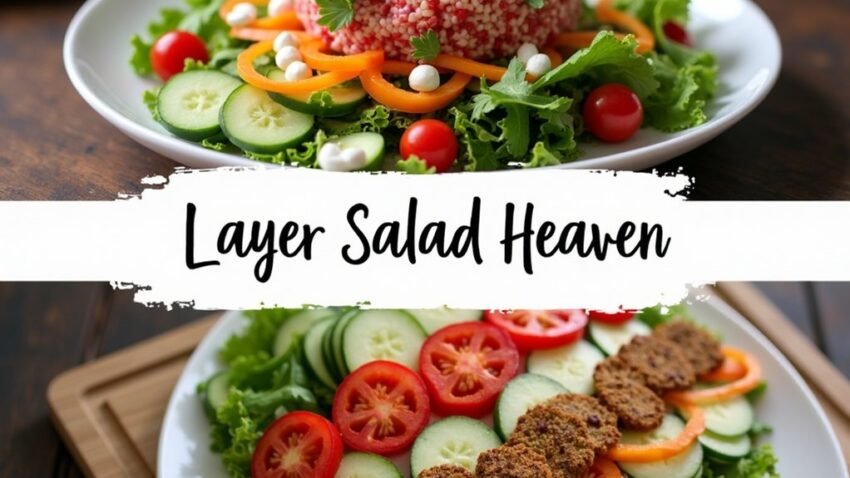7-Layer Salad Heaven

7-Layer Salad Heaven
When you think about classic dishes that spark nostalgia at gatherings, the 7-Layer Salad likely comes to mind. This colorful medley of ingredients isn’t just a feast for the eyes; it’s a canvas for flavors that can surprise even the most discerning palate. As you layer your ingredients, consider how each element contributes to the whole. With its creamy dressing and crispy toppings, the salad invites curiosity about its origins and variations. So, what makes this dish a true Southern staple, and how can you enhance it in your own kitchen?
Key Takeaways
- The 7-Layer Salad is visually stunning, ideal for gatherings and potlucks, showcasing vibrant layers in a clear glass bowl.
- Key ingredients include lettuce, peas, bacon, cheese, and hard-boiled eggs, creating a delicious flavor combination.
- Preparing the salad a day in advance enhances its flavor, allowing ingredients to meld together beautifully.
- The recipe is flexible; customize layers and dressings based on personal preferences and available ingredients.
- Serve without tossing to maintain the layered presentation, using long-handled spoons for easy serving.
History
Salads have a rich history that dates back to ancient times, primarily in Rome, where “herba salata”—salted herbs—was a staple. As you explore the evolution of salads, you’ll uncover that their roots trace back to the ancient and medieval periods. Here are some key developments:
-
Ancient Rome: Salted herbs served as a foundational element.
-
Post-Roman Era: Raw vegetables emerged as medicinal correctives, especially during fast days.
-
Medieval and Renaissance Influence: The term “salad” reentered European cuisines through Spain and Italy, while the Byzantines retained salads in their diet.
-
Early Formats: Salads were often pickled in vinegar and included mixed greens.
During the mid-20th century, the 7 layer salad originated in the Southern United States. It gained traction as a visually appealing dish during the rise of convenience foods.
Additionally, the layering technique reflects the historical influence of composed salads which aimed to enhance both presentation and flavor.
Originally served in glass bowls to showcase its beautiful layers, this dish became a potluck, picnic, and barbecue staple.
Layered salads have evolved, but the traditional 7 layer salad endures, adapting to various tastes while keeping its core essence intact.
This history showcases how salads reflect cultural trends and culinary creativity through time.
Recipe
The 7-Layer Salad is a delightful dish that showcases a beautiful array of colors and textures, making it perfect for gatherings or potlucks. The combination of fresh ingredients and creamy dressing provides a healthy yet indulgent option that pleases a crowd. Each layer blends harmoniously, creating a flavor explosion as you dig into this enticing salad. Preparing the salad a day in advance allows for optimal flavor melding of the ingredients, enhancing the taste experience.
To prepare your 7-Layer Salad, you begin by selecting your ingredients, ensuring each layer stands out visually and complements the others. The salad is constructed in a clear glass bowl, allowing the vibrant layers to be displayed beautifully. It’s best when allowed to chill for at least 24 hours in the fridge, giving the ingredients a chance to meld together while keeping the individual layers distinct.
Ingredients:
– Lettuce (shredded or whole leaves)
– Peas (frozen, thawed under cold water or cooked)
– Bacon (crispy cooked, 4-5 rashers or 1/2 pound)
– Cheese (shredded cheddar or 200g grated tasty cheese)
– Eggs (hard-boiled, 3 eggs, optional)
– Red onion or spring onions
– Mayonnaise (1 cup)
– Sour cream (1 cup or 2 tbsp, optional)
– Sugar (1 tablespoon, optional)
– Garlic powder, onion powder, salt, and pepper
– Lemon juice or apple cider vinegar (optional)
– Celery (optional)
To assemble the salad, start with a layer of shredded lettuce in a clear glass bowl. Next, layer chopped red onion or spring onions over the lettuce, followed by peas, diced celery, and hard-boiled eggs if you’re using them.
Spread a layer of mayonnaise or your chosen dressing over the mixture, and then top with shredded cheese and crispy bacon. Make sure to cover the bowl and refrigerate the salad for at least 24 hours to allow the flavors to meld before serving.
For best results, try to use fresh, high-quality ingredients to enhance the flavors of your salad. You can customize your 7-Layer Salad to suit your dietary preferences, such as omitting bacon for a vegetarian version or experimenting with different cheese varieties.
Don’t hesitate to get creative by adding extra layers of your favorite vegetables, like diced tomatoes or peppers, to make the salad your own!
Final Thoughts
Creating a 7-Layer Salad can be a rewarding culinary adventure that impresses your guests. This dish brings both visual appeal and delightful flavors to any gathering. For the best presentation, opt for a clear glass bowl. Layer your ingredients in this order: lettuce, onions, celery, peas, mayonnaise, cheese, and bacon. Chill your salad for at least a couple of hours before serving, as this improves the flavors. Additionally, using thawed peas ensures that your salad remains fresh and avoids excess moisture.
Here are a few key tips for serving:
-
No Tossing: Tradition holds that the salad isn’t tossed before serving. Use long-handled spoons to help guests mix their portions effectively.
-
Choose Your Dressing: A popular dressing combines mayonnaise, sour cream, and sugar, but feel free to customize it with fresh herbs or garlic.
-
Nutritional Consideration: Be mindful that this salad tends to be high in calories, primarily from fats. Each 100g serving contains approximately 258 calories.
Ultimately, the 7-Layer Salad isn’t just a dish; it’s a symbol of Southern tradition often featured at potlucks and family gatherings.
With its flexibility, you can easily adapt the layers and dressings to suit your tastes and preferences.
FAQ
Regarding making a 7-Layer Salad, you might’ve some questions about the best practices and variations. Here are some key points to reflect upon:
Layer Assembly Tips:
-
Choose a Clear Bowl****: A glass bowl showcases the layers beautifully.
-
Layer Order: Start with lettuce, then add red onion, peas, hard-boiled eggs, dressing, shredded cheese, and finally bacon.
-
Dressing Application: Apply dressing on top or spread it evenly.
Ingredient Variations:
-
Flexible Layers: Feel free to include carrots, cucumbers, or tomatoes.
-
Cheese Options: Use cheddar, blue cheese, or feta.
-
Meat Alternatives: Swap bacon for turkey or ham.
Dressing Tips:
-
Homemade Dressing: Combine mayonnaise with sour cream, sugar, and seasonings.
-
Serving Options: You can layer the dressing or serve it on the side.
General Tips:
-
Visual Presentation: Arrange ingredients for an appealing look.
-
Leftovers: Store in the fridge for up to two days, but it’s best fresh.
-
Nutritional Benefits: Incorporating a variety of vegetables not only enhances flavor but also ensures a boost of high in vitamins in your meal.
